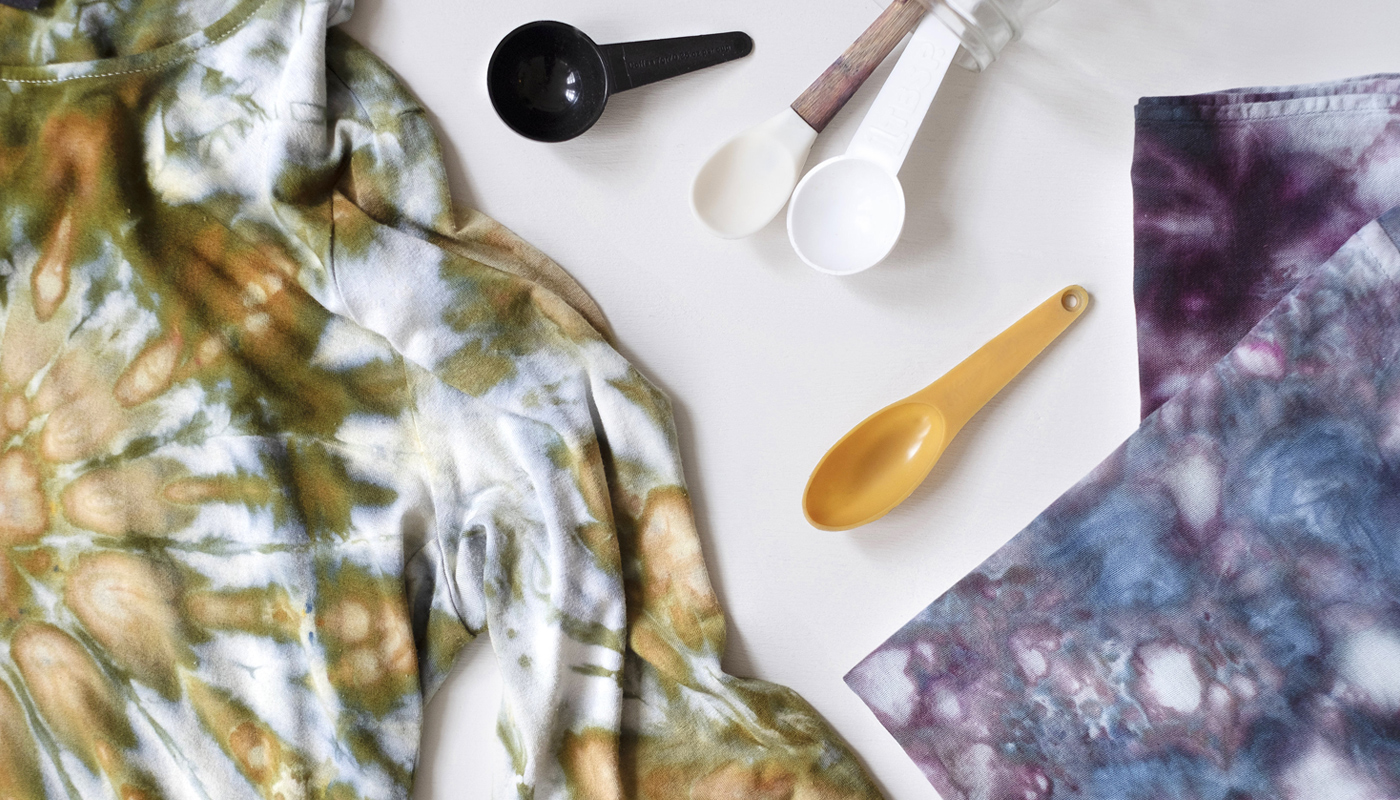
03 Jun A Life in Craft: Interview with Jessica Kaufman, Fiber and Surface Design Artist
Jessica Kaufman is the founder and owner of WAXON Studio in West Asheville, NC. Jess has taught workshops and classes to intergenerational audiences for more than 20 years. With an MA in crafts education, she is an experienced teacher with an inclusive, inventive, and entertaining approach. She joined Tammy Elwell in the Craft Shop to talk about her relationship with the Folk School, her dyeing process, and realizing her dream of creating batik and tie-dye kitchen textiles. Enjoy our interview!
Q & A Section: Folk School Connections
TE: What was your first impression of the Folk School?
JK: I couldn’t believe that something that amazing existed! I grew up going to Penland’s community days and I had no idea that the Folk School existed, until I heard other people my age talking about it. I got the catalog and decided to take a class. I was into my early twenties, had just graduated college, and was teaching high school when I came down to take a pottery class.
My first, first impression, I showed up for student orientation and I was hours early. I had my hammock in my car, and I set it up in those little woods between Field House and Keith House along that beautiful path. I was just hanging out in my hammock, journaling, not really sure, since I had never been there before, and I heard voices. It was Eliza Bell Rosbach and Jamie Sparks walking through the woods with their little clip boards and radios, talking about host things. I was like, I know those ladies, I’ve seen them before at contra dances! I just thought they were so cool and hip. I thought, this is where cool young hippie craftspeople go!
I still go on walks with Jamie around the neighborhood all the time, so, it’s like, here we are 18 years later, and we still have a Folk School friendship.
TE: You first took a clay class in 2005 at the Folk School, are there any lessons you learned in that first class that are still relevant for you today?
JK: Yes, that you can make a life in craft, in folk craft. I think Ted Cooley was the assistant instructor in that class, and I remember just listening to him talk about what his life was like. Going around doing crafty and musical things. I just went, oh, that’s a life choice.
I went straight from high school into college and then straight from college into teaching. Even though it was artistic, I was already sick and tired of being sick and tired when I was 23 or 24. Just being around these people who have so much more life in them, I thought, that’s what I want!
TE: Did you do the Student Host program right after that?
JK: Actually, it was five years later that I did the host program. I talked to Jamie and Eliza about it, and I realized that hosting was a thing you could do! Then it took a couple years to get the courage up and arrange my life so that I could apply.
TE: You were a Student Host in 2009. Has your experience in the program continued to influence and enrich your creative life?
JK: Oh my gosh, HUGELY! I still consider being a host one of the pinnacles of my early craft career. I was immersed and involved in every single way with craftspeople, handcraft, and the lifestyle of craft in the southern United States. Working on a very real day-to-day basis, not only for a major craft organization but with artists, instructors, and students of all levels was wildly influential.
TE: How would you describe the Folk School to someone who has never been?
JK: I would say it’s like adult summer camp but only the crafts cabin. I like to tell them about the different studios, for me, that’s the candyland part. There’s a studio for almost everything! I consider myself a multi-craftsperson: multi-genre, multi-material, so for someone who enjoys a multifaceted experience it’s really perfect. I want to dabble! I like interdisciplinary exploration instead of being in a program that focuses on one area for three or four weeks.
TE: Absolutely. You could take a different kind of class every week for a month if you wanted to! In the current catalogue there are new multi-studio classes where students get a chance to be with several instructors in various studios working toward a multi-material finished project.
JK: YES! Imagine if you could be in the Wet Room dyeing fabrics and then go up to the Quilting studio to make it into a quilt or a wall hanging.
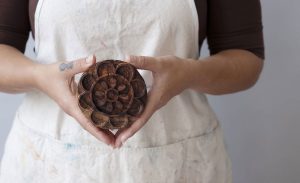
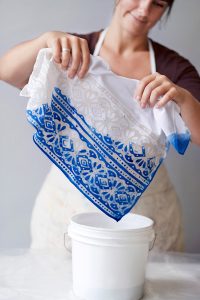
Q & A: The Process/Inspiration
TE: For people who may not be familiar, can you touch on the origins of the batik and tie-dye traditions that you work with?
JK: The batik that I’m mostly interested in is repeating designs placed on fabric with stamps (either metal or handcarved wood). I started by doing batik with a lot of hand drawing and painting, using paintbrushes. I’m getting back into what I’m calling traditional, but that’s such a big word, traditional to where, to who, to when? I’m referring to the traditional Malaysian stamps and the handcarved Indian woodblocks.
We believe that batik, as a wax resist form of dyeing, originated in Indonesia. Then it travelled out, with migration and the silk road. All the ways that things travelled at the time. Different parts of the world have their own ancient batik traditions spanning thousands of years, and they’re all slightly different. Indonesia does claim firsts. It’s interesting because resist dyeing (putting things on the cloth to resist the dye) has changed as it’s travelled around the world. Mostly, when we say batik, we mean wax resist dyeing. In parts of Japan and Asia they use a rice paste resist and in parts of Africa they use mud. What I’m doing is pure beeswax, stamped or brushed onto fabric, then dyed, and then boiled to remove the wax.
TE: You’re using some of the traditions from India with handcarved stamps from teak blocks? Can you talk about how that process works?
JK: Yeah, I’m using blocks made from Burmese teak. I’m lucky that I got to go travel and study with a family that has been passing these blocks down from generation to generation and still make their living from batik. In that part of India, the batik artists make the fabric, the fabric goes to the fabric store, and when the family needs new clothes mom, sisters, and aunties go and buy these lengths of cloth. The cloth is pre-made and pre-cut for an exact style of garment called the shalwar kameez (a flowy top paired with flowy pants). Which is so cool, it’s just so unique! So, that’s who I got to study with; a family that is used to producing meters of fabric a day for their specific local garment industry. It’s not sweatshop production and it’s not big production. They make about 20 outfits per day that go directly to smaller stores in villages where real families are going to buy their fabric for everyday wear.
TE: Are you keeping in contact with the family you studied with?
JK: We connect over social media. There’s definitely a language and cultural barrier but we keep in touch and ask how each other are doing, how things are going, and if everyone is well.
TE: It’s wonderful that you can continue to connect with them, learn from their traditions and build a friendship across culture.
JK: That makes it even more important to me to go back! If I just went once, that feels like sampling someone else’s culture but if I get to go back, you know, I’ll get to really show up and care for them in ways that are important. It’s so delicate. We have so much more here. We have more money, more expenses, more stress, worry, anxiety and complications. When I was there, I really appreciated the pace of life.
TE: What is your personal creative process like? How does your inspiration for new concepts and designs form?
JK: Thank you for asking that; as I have plunged into entrepreneurship, I have found my creative process to be pretty stifled. My focus, like it or not, over the last couple years, has been more about efficiency and production.
It has been important for me to find ways to relax and rediscover the joy that I feel for color, shape, and texture. That’s what inspires me, that, and live music!
TE: Do you create your own dye colors?
JK: Yeah. I use fiber reactive dyes from Dharma Trading Company but I’m always combining leftovers, using them, or mixing them not at full strength, doing all kinds of combos. I’m often, to my chagrin, creating colorways that cannot be repeated and I’m okay with that!
TE: That’s great; I like the fact that it can be so ephemeral.
JK: Something that I put in my listings all the time, is that dye lots will change from batch to batch. If you want things to match exactly, they need to be made at the same time.
TE: What do you look for when you source your material?
JK: I use natural cellulose-based fabrics because the dyes work best with those fibers. This year I’ve switched to using organic cotton and hemp. My fabrics do have a little Lycra® in them, for the garments that need negative ease, like the leggings, crop tops, or dresses. They need a little stretch. I will sacrifice the 100% natural and add in that 3% Lycra® for better fit and function. That’s my concession.
I’m getting all sustainably sourced fair-trade fabrics on bolts now, which is really great. When I started, I was upcycling garments and overdyeing them. For my new venture (cut and sewn garments made to order) I’m getting fabric on the bolt.
And then for the Craft Shop, we’re doing table linens (tea towels and napkin sets). Those are all woven using 100% cotton and hemmed with cotton thread. We’re serging the edges on the tea towels ourselves so that we don’t have polyester threads in anything, at all.
TE: Is that so it takes up the dye and blends in with the color of the towel?
JK: Absolutely, and polyester threads don’t boil wax out very well. By having 100% hemmed with cotton thread it just looks better and it saves us a lot of time. That’s my little snob point. I don’t feel as good producing things that have polyester trim on them. It makes things a little more difficult, but I feel more pride in the finished product.
TE: What brings you the most joy from concept to finished piece?
JK: Seeing my pieces on people, especially when I’ve been out vending at a music festival or a craft show. That people want to buy my garments, put them on, and then wear them for the rest of the day. I know this is super focused on apparel and not kitchen linens but that’s the biggest sense of finished accomplishment; to see them working on people’s bodies.
TE: How do you overcome roadblocks in your creative process?
JK: I’m an external processer, so I need to talk about it a lot! I talk about it with friends, helpers, people who are not artists, people who are artists. Everyone has got an opinion and or something to say, and even if I don’t agree with their opinion, it helps clarify for me what I want.
TE: You’ve been working in this medium for how long now?
JK: It’s 2021 so I think I’m at about 20 or 21 years. I count from when I started teaching tie-dye at summer camp. That’s where I really started learning fiber reactive dyes and how they work. I was teaching 1,000 eight-year-old campers how to tie-dye a shirt from start to finish. Best training ever!
TE: What is it about surface design, textiles, and dyes that continue to attract and fascinate you?
JK: Honestly, I’m fulfilling my early childhood desire for clothing design. I threw it away so early! I thought I couldn’t do clothing design because I wasn’t a fashion model. I wasn’t built like a fashion model and thought that no one would hire me as a short, dark, and curvy person. I was like, I’m not going to be involved in fashion, so I’ll do theater and be a teacher. Now that I have this business, I can steer it in any direction! I can ask: what if it looked like this, what if we created this, what bodies will this work on, and how can I change it so it’s even cooler?
TE: You’ve said that making kitchen textiles has been a dream of yours for a long time. Why is that? Do you spend a lot of time in the kitchen?
JK: I do more now that my business is five years old. For the first three years I couldn’t find time to cook for myself at all. I was the biggest shopper at the Whole Foods hot bar! Now that I have employees, I’m going home to make lunch and cooking more. What’s inspiring me is how my work can go with kitchen pottery! I’m inspired by the huge success and quality of East Fork, which is another small Asheville artist business that has now exploded and grown into production pottery. Now I’m asking myself what can I contribute to a beautiful table setting? I’m the fabric person, so what am I going to make?
I love food, pottery, and cooking implements, so I want to be involved! Just because I’m a fabrics person doesn’t mean that I have to stay in clothing. Now I’m making napkins and tea towels. I’m thinking about what other home goods I can make.
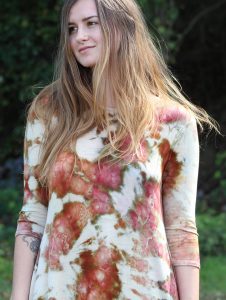
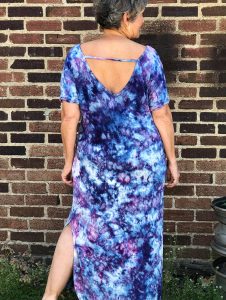
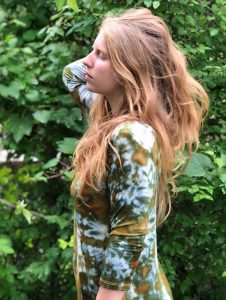
Q & A:
TE: Do you have a favorite product that you’re making right now?
JK: It’s always the thing that I’m working on right now, in the moment.
TE: How would you like your work to connect with people who purchase it?
JK: I think if they can begin to identify just how much of it was handmade. For example, the linens that are at the Craft Shop, the blocks that I used to print the patterns were handcarved, the dyes are hand mixed, we’re boiling out every single piece and shaking it out, so just knowing how much hands-on time, how much love, and how much process has gone into each piece. Which is true of absolutely everything that the Craft Shop sells! I think that’s a unique shopping experience.
TE: Do you have any advice for emerging craftspeople who want to make their living with craft?
JK: As soon as you can afford to: get help at whatever part you hate the most. If you hate accounting, spend every penny of your profit on an accountant. We can’t do everything and that’s where we burn out. So, every chance I get I delegate a task to someone else who can help me. I want to have a team working for my vision. It’s not just me trying to do everything. You can’t work in your business and on your business at the same time. Get people to help you in the business so you can work on your business.
TE: What was the most influential advice that you’ve been given?
JK: It’s okay if it fails. That’s something that I need to hear over and over and over. The majority of small businesses fail and the majority of the crafts professionals that I know say things like that’s what I was doing ten years ago, now I’m doing this instead. Be willing to try because it doesn’t have to last forever. What’s the best shot I can give it today?
View Jessica’s Work in the Craft Shop
Here is a sampling of Jessica’s hand-dyed napkins and tea towels. To see what is available for purchase currently, visit craftshop.www.folkschool.org.
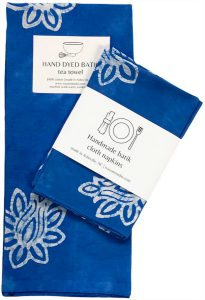
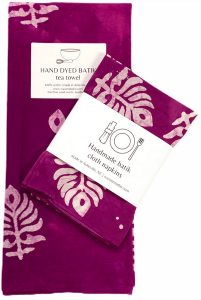
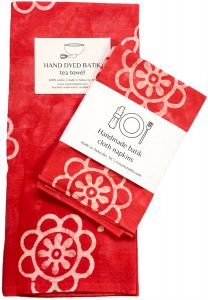
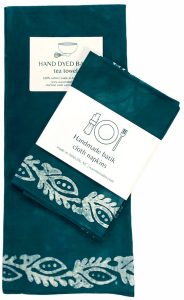



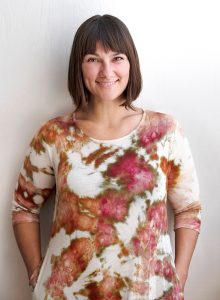
No Comments